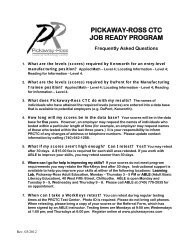Commons
Conceptual Physics - elearning-phys
Conceptual Physics - elearning-phys
- No tags were found...
Create successful ePaper yourself
Turn your PDF publications into a flip-book with our unique Google optimized e-Paper software.
p / A bowling ball is in the back of a pickup truck turning left. Themotion is viewed first in a frame that turns along with the truck, 1, andthen in an inertial frame, 2.2.4 Newton’s TriumphIsaac Newton’s greatest triumph was his explanation of the motionof the planets in terms of universal physical laws. It was a tremendouspsychological revolution: for the first time, both heaven andearth were seen as operating automatically according to the samerules.Newton wouldn’t have been able to figure out why the planetsmove the way they do if it hadn’t been for the astronomer TychoBrahe (1546-1601) and his protege Johannes Kepler (1571-1630),who together came up with the first simple and accurate descriptionof how the planets actually do move. The difficulty of their task issuggested by figure q, which shows how the relatively simple orbitalmotions of the earth and Mars combine so that as seen from earthMars appears to be staggering in loops like a drunken sailor.Brahe, the last of the great naked-eye astronomers, collected extensivedata on the motions of the planets over a period of manyyears, taking the giant step from the previous observations’ accuracyof about 10 minutes of arc (10/60 of a degree) to an unprecedented1 minute. The quality of his work is all the more remarkable consideringthat his observatory consisted of four giant brass protractorsmounted upright in his castle in Denmark. Four different observerswould simultaneously measure the position of a planet in order tocheck for mistakes and reduce random errors.With Brahe’s death, it fell to his former assistant Kepler to tryto make some sense out of the volumes of data. Kepler, in con-r / Tycho Brahe made his nameas an astronomer by showing thatthe bright new star, today calleda supernova, that appeared inthe skies in 1572 was far beyondthe Earth’s atmosphere. This,along with Galileo’s discovery ofsunspots, showed that contraryto Aristotle, the heavens werenot perfect and unchanging.Brahe’s fame as an astronomerbrought him patronage from KingFrederick II, allowing him to carryout his historic high-precisionmeasurements of the planets’motions. A contradictory character,Brahe enjoyed lecturing othernobles about the evils of dueling,but had lost his own nose in ayouthful duel and had it replacedwith a prosthesis made of analloy of gold and silver. Willing toendure scandal in order to marrya peasant, he nevertheless usedthe feudal powers given to him bythe king to impose harsh forcedlabor on the inhabitants of hisparishes. The result of their work,an Italian-style palace with anobservatory on top, surely ranksas one of the most luxuriousscience labs ever built. He diedof a ruptured bladder after fallingfrom a wagon on the way homefrom a party — in those days, itwas considered rude to leave thedinner table to relieve oneself.Section 2.4 Newton’s Triumph 55



